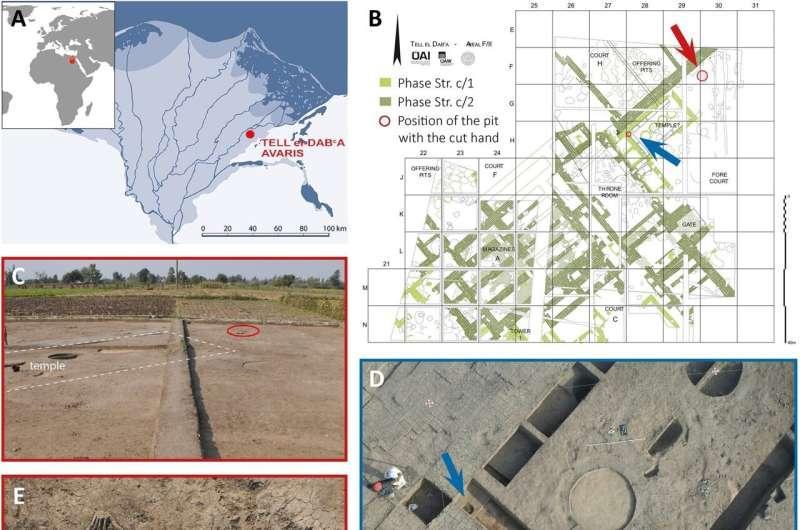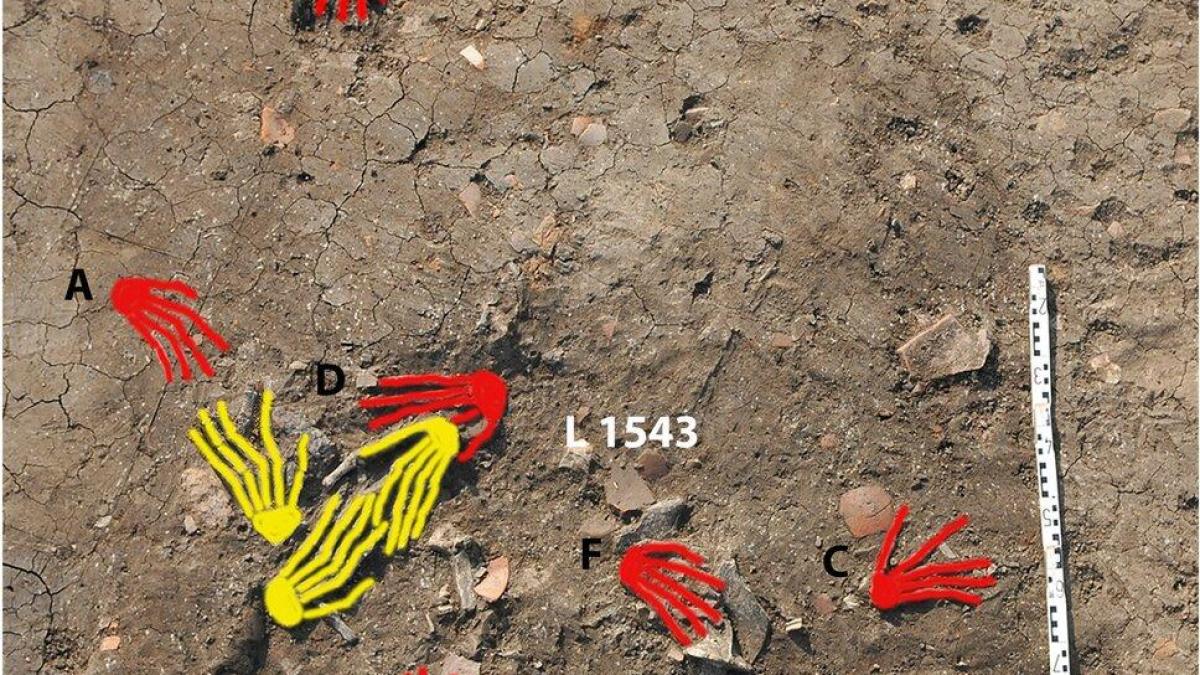Justin Jackson , Phys.org
Source - https://phys.org/news/2023-04-palace-pits-severed-ancient-egyptian.html
 Archaeological evidence of severed hands in Hyksos Period Tell el-Dab‘a, Northern Egypt (images ÖAI, M. Bietak): (A) Nile Delta, Northern Egypt (Apple maps) and position of the site Tell el-Dab‘a/Avaris in the Nile Delta. This map has been modified from Fig. 1 (drawn by Nicola Math, modified by Dominik Fill, Austrian Academy of Sciences) in: Manfred Bietak, "Hyksos" in "Hyksos," R. Bagnell, et al. (eds.), Encyclopedia of Ancient History, vol. 6, 1st edition, Malden, MA- Oxford 2013: Wiley-Blackwell, 3356–3362. To publish the map under a CC BY open access license is permitted by the copyright holder Manfred Bietak. (B) Northern part of the Hyksos Palace at Tell el-Dab‘a, Phase E1-D3 (after Bietak et al. 2012/13). Red arrow indicating Pit L1542 and 1543, blue arrow indicating Pit L1777. (C) Overview of the area of Pit L1542 and 1543 (red circle), the excavation layer closely beneath the modern surface in the agricultural area. (D) South wall of a later added broad-room building built against the western enclosure wall of the palace’s forecourt. Pit L 1777 in front of the throne room (indicated by the arrow). (E) Overview of the 11 right hands in the Pits L1542 and L1543. (F) Single right hand on its palmar surface with wide-splayed fingers. Credit: Scientific Reports (2023). DOI: 10.1038/s41598-023-32165-8
Archaeological evidence of severed hands in Hyksos Period Tell el-Dab‘a, Northern Egypt (images ÖAI, M. Bietak): (A) Nile Delta, Northern Egypt (Apple maps) and position of the site Tell el-Dab‘a/Avaris in the Nile Delta. This map has been modified from Fig. 1 (drawn by Nicola Math, modified by Dominik Fill, Austrian Academy of Sciences) in: Manfred Bietak, "Hyksos" in "Hyksos," R. Bagnell, et al. (eds.), Encyclopedia of Ancient History, vol. 6, 1st edition, Malden, MA- Oxford 2013: Wiley-Blackwell, 3356–3362. To publish the map under a CC BY open access license is permitted by the copyright holder Manfred Bietak. (B) Northern part of the Hyksos Palace at Tell el-Dab‘a, Phase E1-D3 (after Bietak et al. 2012/13). Red arrow indicating Pit L1542 and 1543, blue arrow indicating Pit L1777. (C) Overview of the area of Pit L1542 and 1543 (red circle), the excavation layer closely beneath the modern surface in the agricultural area. (D) South wall of a later added broad-room building built against the western enclosure wall of the palace’s forecourt. Pit L 1777 in front of the throne room (indicated by the arrow). (E) Overview of the 11 right hands in the Pits L1542 and L1543. (F) Single right hand on its palmar surface with wide-splayed fingers. Credit: Scientific Reports (2023). DOI: 10.1038/s41598-023-32165-8
The first physical evidence of an ancient practice previously known only from iconographic and literary sources—12 to 18 right hands buried beneath pits in an ancient Egyptian palace—has been analyzed by a team of researchers led by Julia Gresky of the German Archaeological Institute in Berlin.
The researchers report the details of the grisly find and offer some insight into why a dozen hands were deposited this way in their paper, "First osteological evidence of severed hands in Ancient Egypt," published in the journal Scientific Reports. The excavation site the hands were discovered in dates to about 1640–1530 BC in the forecourt of Hyksos palace at Avaris in northeastern Egypt.
The Hyksos kings were most likely individuals from the local population with strong cultural connections to the Levant or western Asia. This was during a time when the central power of Egypt was contracting, though it would soon rebound with help from an influx of technology from its culturally blended immigrant population, including the horse and chariot.
The hands were found in three separate pits in what would have been the entrance court of the palace directly in front of the throne room. The severed hands placed in such a location were likely intended to be seen and would have made an impactful sight. Whatever business a visitor to see the king might have was certainly placed into a new perspective at the sight of so many dismembered hands.
Because the hands were not all fully intact and were interred together, the researchers had to employ a determination common in mixed grave sites of figuring out the minimum and maximum number of individuals required to make up the remains. The minimum was found to be 12, with 18 being the uppermost range.
 Anthropological reconstruction of the finding and details of the right hands of Pits L1542, L1543 (reconstruction and images of single hands, J. Gresky): reconstruction of the complete hands in the Pits L1542 (left upper corner) and L1543 (lower half of the picture). Yellow hands are placed on their dorsal surface whereas the red ones are placed on their palmar. The missing elements are reconstructed. (A,C–F) eight right hands of Pit L1543, together with single phalanges which could either represent additional hands or might belong to the present hands. The preserved bones are colored. (B) Three right hands on their palmar surface in Pit L1542. The preserved bones are color. Credit: Scientific Reports (2023). DOI: 10.1038/s41598-023-32165-8
Anthropological reconstruction of the finding and details of the right hands of Pits L1542, L1543 (reconstruction and images of single hands, J. Gresky): reconstruction of the complete hands in the Pits L1542 (left upper corner) and L1543 (lower half of the picture). Yellow hands are placed on their dorsal surface whereas the red ones are placed on their palmar. The missing elements are reconstructed. (A,C–F) eight right hands of Pit L1543, together with single phalanges which could either represent additional hands or might belong to the present hands. The preserved bones are colored. (B) Three right hands on their palmar surface in Pit L1542. The preserved bones are color. Credit: Scientific Reports (2023). DOI: 10.1038/s41598-023-32165-8
Forensically, hands can be difficult to assess as there are fewer age or sex-dependent features than, for example, a pelvis or skull might offer. The minimum ages for the hands were set at between 14 to 21 years, as the bones were fully formed post-adolescence. With no signs of age-related degeneration, the upper age range was below 60.
For sex determination, the researchers used the robust nature of the bones and a morphological tendency for male index fingers to be longer than their ring fingers. 11 of the hands were determined to be male, with the 12th undetermined. Though undetermined, the 12th hand could very well be female, according to the authors, as there was little insulation from the dangers of war or conflict for women of that time in Egypt.
There is a slight mystery regarding timing, whether the hands were acquired from deceased or living individuals. In either case, according to the researchers, "...the hands must have been soft and flexible when they were placed into the pit." The most likely scenario, the analysis reasons, is between 24 and 48 hours after collection, the hands found their way to the pits. This suggests that at least a day passed between amputation and placement in the palace.
Another interesting feature is the lack of any sign of the forearms the hands were once attached to. This indicates that a level of care was taken in removing any sign of the appendage so that only the anatomical hands would be on display. However, it is impossible to tell if the hands were taken cleanly off the arms or were cleaned up after a less-than-neat removal procedure.
While there is little evidence of hand severing previous to the time period of the pits, it does surface in iconographic accounts 50 to 80 years later. The authors suggest that if this is indeed the origin of the activity in Egypt, it may have originated in the communities from which the Hyksos leadership originated. As the cultures mixed, the practice may have caught on.
While the Hyksos Avaris hands may have been part of a ceremony at the palace, taking a hand from an enemy became a traditional practice in warfare in the dynasties that followed, according to iconographic records. This is the first reported discovery of physical evidence of the practice.
Julia Gresky et al, First osteological evidence of severed hands in Ancient Egypt, Scientific Reports (2023). DOI: 10.1038/s41598-023-32165-8